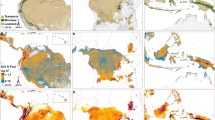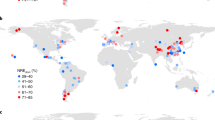Abstract
As soils develop in humid environments, rock-derived elements are gradually lost, and under constant conditions it seems that ecosystems should reach a state of profound and irreversible nutrient depletion. We show here that inputs of elements from the atmosphere can sustain the productivity of Hawaiian rainforests on highly weathered soils. Cations are supplied in marine aerosols and phosphorus is deposited in dust from central Asia, which is over 6,000 km away.
This is a preview of subscription content, access via your institution
Access options
Subscribe to this journal
Receive 51 print issues and online access
$199.00 per year
only $3.90 per issue
Buy this article
- Purchase on Springer Link
- Instant access to full article PDF
Prices may be subject to local taxes which are calculated during checkout








Similar content being viewed by others
References
Aber, J. D. & Melillo, J. M. Terrestrial Ecosystems(Saunders, Philadelphia, (1991)).
Schlesinger, W. H. Biogeochemistry: An Analysis of Global Change 2nd edn(Academic, San Diego, (1996)).
Walker, T. W. & Syers, J. K. The fate of phosphorus during pedogenesis. Geoderma 15, 1–19 (1976).
Stevens, P. R. & Walker, T. W. The chronosequence concept and soil formation. Q. Rev. Biol. 45, 333–350 (1970).
Gorham, E., Vitousek, P. M. & Reiners, W. A. The regulation of element budgets over the course of terrestrial ecosystem succession. Annu. Rev. Ecol. System. 10, 53–84 (1979).
Chapin, F. S., Walker, L. R., Fastie, C. L. & Sharman, L. C. Mechanisms of primary succession following deglaciation at Glacier Bay, Alaska. Ecol. Monogr. 64, 149–175 (1994).
Cole, C. V. & Heil, R. D. in Terrestrial Nitrogen Cycles(eds Clark, F. E. & Rosswall, T. H.) 363–374 (Ecol. Bul. 33, Stockholm, (1981)).
Likens, G. E. & Bormann, F. H. Biogeochemistry of a Forested Ecosystem 2nd edn(Springer, New York, (1995)).
Hedin, L. O., Armesto, J. J. & Johnson, A. H. Patterns of nutrient loss from unpolluted, old growth temperate forests: evaluation of biogeochmecial theory. Ecology 76, 493–509 (1995).
Hedin, L. O. et al. Steep declines in atmospheric base cations in regions of Europe and North America. Nature 367, 351–354 (1994).
Tegen, I. & Fung, I. Y. Modeling of mineral dust in the atmosphere: sources, transport, and optical thickness. J. Geophys. Res. 99, 22897–22914 (1994).
Swap, R., Garstang, M., Greco, S., Talbot, R. & Kallbert, P. Saharan dust in the Amazon Basin. Tellus 44 B, 133–149 (1992).
Propero, J. M., Glaccum, R. A. & Nees, R. T. Atmospheric transport of soil dust from Africa to South America. Nature 289, 570–572 (1981).
Uematsu, M. et al. Transport of mineral aerosol from Asia over the North Pacific Ocean. J. Geophys. Res. 88, 5343–5452 (1983).
Lindberg, S. E. & Owens, J. G. Throughfall studies of deposition to forest edges and gaps in montane ecosystems. Biogeochemistry 19, 173–194 (1993).
Lovett, G. M. Atmosphere deposition of nutrients and pollutants to North America: an ecological perspective. Ecol. Appl. 4, 629–650 (1994).
Weathers, K. C. & Likens, G. E. Clouds in southern Chile: An important source of nitrogen to nitrogen-limited ecosystems. Environ. Sci. Technol. 31, 210–213 (1997).
Heath, J. A. & Huebert, B. J. Cloudwater deposition as a source of fixed nitrogen in a Hawaiian montane forest. Biogeochemistry(in the press).
Cao, M. K. & Woodward, F. I. Dynamic responses of terrestrial ecosystem carbon cycling to global climate change. Nature 393, 249–252 (1998).
Aplet, G. H., Hughes, R. F. & Vitousek, P. M. Ecosystem development on Hawaiian lava flows: biomass and species composition. J. Veg. Sci. 9, 17–26 (1998).
Austin, A. T. & Vitousek, P. M. Nutrient dynamics on a precipitation gradient in Hawaii. Oecologia 113, 519–529 (1998).
Schimel, D. S. et al. Climatic, edaphic, and biotic controls over carbon and turnover of carbon in soils. Global Biogeochem. Cyc. 8, 279–293 (1994).
Vitousek, P. M. et al. Human alteration of the global nitrogen cycle: sources and consequences. Ecol. Appl. 7, 737–750 (1997).
Aber, J. D. et al. Nitrogen saturation in temperate forest ecosystems: hypothesis revisited. Bioscience 48, 921–934 (1998).
Schimel, D. S. et al. Climate and nitrogen control on the geography and timescales of terrestrial biogeochemal cycling. Global Biogeochem. Cyc. 10, 677–692 (1996).
Moore, J. G. & Clague, D. A. Volcano growth and evolution of the island of Hawaii. Geol. Soc. Am. Bull. 104, 1471–1484 (1992).
Clague, D. A. & Dalrymple, G. B. in Volcanism in Hawaii(eds Decker, R. W. et al.) 5–73 (US Geol. Surv. Prof. Paper 1350, (1987)).
Wright, T. C. & Helz, R. T. in Volcanism in Hawaii(eds Decker, R. W. et al.) 625–640 (US Geol. Surv. Prof. Paper 1350, (1987)).
Macdonald, G. A., Abbott, A. T. & Peterson, F. L. Volcanoes in the Sea 2nd edn(Univ. Hawaii Press, Honolulu, (1983)).
Wagner, W. L., Herbst, D. R. & Sohmer, S. H. Manual of the Flowering Plants of Hawaii(Bishop Museum Spec. Publ. 83, Univ. Hawaii Press, Honolulu, (1990)).
Jenny, H. Soil Genesis with Ecological Perspectives. (Springer, New York, (1980)).
Pickett, S. T. A. in Long-Term Studies in Ecology: Approaches and Alternatives(ed. Likens, G. E.) 110–135 (Springer, New York, (1989)).
Porter, S. C. Hawaiian glacial ages. Quat. Res. 12, 161–187 (1979).
Gavenda, R. T. Hawaiian Quaternary paleoenvironments: A review of geological, pedological, and botanical evidence. Pacific Sci. 46, 295–307 (1992).
Hotchkiss, S. C. Quaternary Vegetation and Climate of Hawaii(thesis, Univ. Minnesota, Minneapolis, (1998)).
Ludwig, K. R., Szabo, B. J., Moore, J. G. & Simmons, K. R. Crustal subsidence rate off Hawaii determined from 234U/238U ages of drowned coral reefs. Geology 19, 171–174 (1991).
Torn, M. S., Trumbore, S. E., Chadwick, O. A., Vitousek, P. M. & Hendricks, D. M. Mineral control of soil carbon storage and turnover. Nature 389, 170–173 (1997).
Vitousek, P. M. et al. Soil and ecosystem development across the Hawaiian Islands. GSA Today 7(9), 1–8 (1997).
Crews, T. et al. Changes in soil phosphorus and ecosystem dynamics across a long soil chronosequence in Hawaii. Ecology 76, 1407–1424 (1995).
Vitousek, P. M. & Farrington, H. Nutrient limitation and soil development: experimental test of a biogeochemical theory. Biogeochemistry 37, 63–75 (1997).
Kitayama, K. & Mueller-Dombois, D. Vegetation changes during long-term soil development in the Hawaiian montane rainforest zone. Vegetatio 120, 1–20 (1995).
Vitousek, P. M., Turner, D. R. & Kitayama, K. Foliar nutrients during long-term soil development in Hawaiian montane rain forest. Ecology 76, 712–720 (1995).
Herbert, D. A. Primary Productivity and Resource use in Metrosideros Polymorpha Forest as Influenced by Nutrient Availability and Hurricane Iniki(thesis, Univ. Hawaii at Manoa, Honolulu, (1995)).
Vitousek, P. M., Walker, L. R., Whiteaker, L. D. & Matson, P. A. Nutrient limitation to plant growth during primary succession in Hawaii Volcanoes National Park. Biogeochemistry 23, 197–215 (1993).
Herbert, D. A. & Fownes, J. H. Phosphorus limitation of forest leaf area and net primary productivity on a weathered tropical soil. Biogeochemistry 29, 223–235 (1995).
Graustein, W. C. in Stable Isotopes in Ecological research(eds Rundel, P. W., Ehleinger, J. R. & Nagy, K. A.) 491–512 (Springer, New York, (1989)).
Capo, R. C., Stewart, B. W. & Chadwick, O. A. Strontium isotopes as tracers of ecosystem processes: Theory and methods. Geoderma 83, 515–524 (1998).
Kennedy, M. J., Chadwick, O. A., Vitousek, P. M., Derry, L. A. & Hendricks, D. M. Changing sources of base cations during ecosystem development, Hawaiian Islands. Geology 26, 1015–1018 (1998).
Newman, E. I. Phosphorus inputs to terrestrial ecosystems. J. Ecol. 83, 713–726 (1995).
Graham, W. F. & Duce, R. A. Atmospheric pathways of the phosphorus cycle. Geochim. Cosmochim. Acta 43, 1195–1208 (1979).
Duce, R. A. et al. The atmospheric input of trace species ot the world ocean. Global Biogeochem. Cyc. 5, 193–259 (1991).
Rea, D. K. The paleoclimatic record provided by eolian deposition in the deep sea: the geological history of wind. Rev. Geophys. 32, 159–195 (1994).
Parrington, J. R., Zoller, W. H. & Aras, N. K. Asian dust: seasonal transport to the Hawaiian Islands. Science 220, 195–197 (1983).
Uematsu, M., Duce, R. A. & Prospero, J. M. Depostion of atmospheric mineral particles to the North Pacific Ocean. J. Atmos. Chem. 3, 123–138 (1985).
Jackson, M. L. et al. Geomorphological relationships of tropospherically derived quartz in soils of the Hawaiian Islands. Soil Sci. Soc. Am. J. 35, 515–525 (1971).
Dymond, J., Biscaye, P. E. & Rex, R. W. Eolian origin of mica in Hawaiian soils. Geol. Soc. Am. Bull. 85, 37–40 (1974).
Taylor, S. R. & McClennan, S. M. The geochemical evolution of the continental crust. Rev. Geophys. 33, 241–265 (1995).
Nakai, S., Halliday, A. N. & Rea, D. K. Provenance of dust in the Pacific Ocean. Earth Planet. Sci. Lett. 119, 143–157 (1993).
Chen, C. Y. & Frey, F. A. Origin of Hawaiian tholeiite and alkalic basalt. Nature 302, 785–789 (1983).
Feigenson, M. D. Constraints on the origin of Hawaiian lavas. J. Geophys. Res. 91, 9383–9393 (1986).
Zieman, J. J. et al. Atmospheric aerosol trace element chemistry at Mauna Loa Observatory 1. 1979–1985. J. Geophys. Res. 100, 25979–25994 (1995).
Birkeland, P. W. Soils and Geomorphology(Oxford Univ. Press, New York, (1984)).
Bull, W. B. Geomorphic Responses to Climate Change(Oxford Univ. Press, New York, (1991)).
Paton, T. R., Humphreys, G. S. & Mitchell, P. B. Soils: A New Global View(Yale Univ. Press, New Haven, (1995)).
Simonson, R. W. Airborne dust and its significance to soils. Geoderma 65, 1–43 (1995).
Berner, E. K. & Berner, R. A. Global Environment: Water, Air, and Geochemical Cycles(Prentice Hall, Upper Saddle River, NJ, (1996)).
Brimhall, G. H. et al. Deformational mass transport and invasive processes in soil evolution. Science 255, 695–702 (1992).
Brimhall, G. H. et al. Metal enrichment in bauxites by deposition of chemically mature aeolian dust. Nature 333, 819–824 (1988).
DePaolo, D. J. & Wasserburg, G. J. Nd isotopic variations and petrogenic models. Geophys. Res. Lett. 3, 249–252 (1976).
Graham, W. F. & Duce, R. A. Atmospheric input of phosphorus to remote tropical islands. Pacific Sci. 35, 241–255 (1981).
Chadwick, O. A., Brimhall, G. H. & Hendricks, D. M. From a black to a gray box: a mass balance interpretation of pedogenesis. Geomorphology 3, 369–390 (1990).
Acknowledgements
This research was supported by the Andrew Mellon Foundation, by the NSF, and by NASA-MTPE. For logistical assistance and access to sites, we are indebted to USDA–National Resources Conservation Service, USGS–Biological Resources Division, Hawaii Volcanoes National Park, Hawaii DL&NR, the Nature Conservancy, and Parker Ranch.
Author information
Authors and Affiliations
Corresponding author
Rights and permissions
About this article
Cite this article
Chadwick, O., Derry, L., Vitousek, P. et al. Changing sources of nutrients during four million years of ecosystem development. Nature 397, 491–497 (1999). https://doi.org/10.1038/17276
Issue Date:
DOI: https://doi.org/10.1038/17276
This article is cited by
-
Deposition is a phosphorus source for Fallopia japonica during early-stage primary succession
Scientific Reports (2023)
-
Globally consistent response of plant microbiome diversity across hosts and continents to soil nutrients and herbivores
Nature Communications (2023)
-
Substantial Organic and Particulate Nitrogen and Phosphorus Export from Geomorphologically Stable African Tropical Forest Landscapes
Ecosystems (2023)
-
Patterns and driving factors of soil nutrient stoichiometry under three land use types in the alpine region of Tibet, China
Journal of Soils and Sediments (2023)
-
Global Positive Effects of Litter Inputs on Soil Nitrogen Pools and Fluxes
Ecosystems (2023)
Comments
By submitting a comment you agree to abide by our Terms and Community Guidelines. If you find something abusive or that does not comply with our terms or guidelines please flag it as inappropriate.



